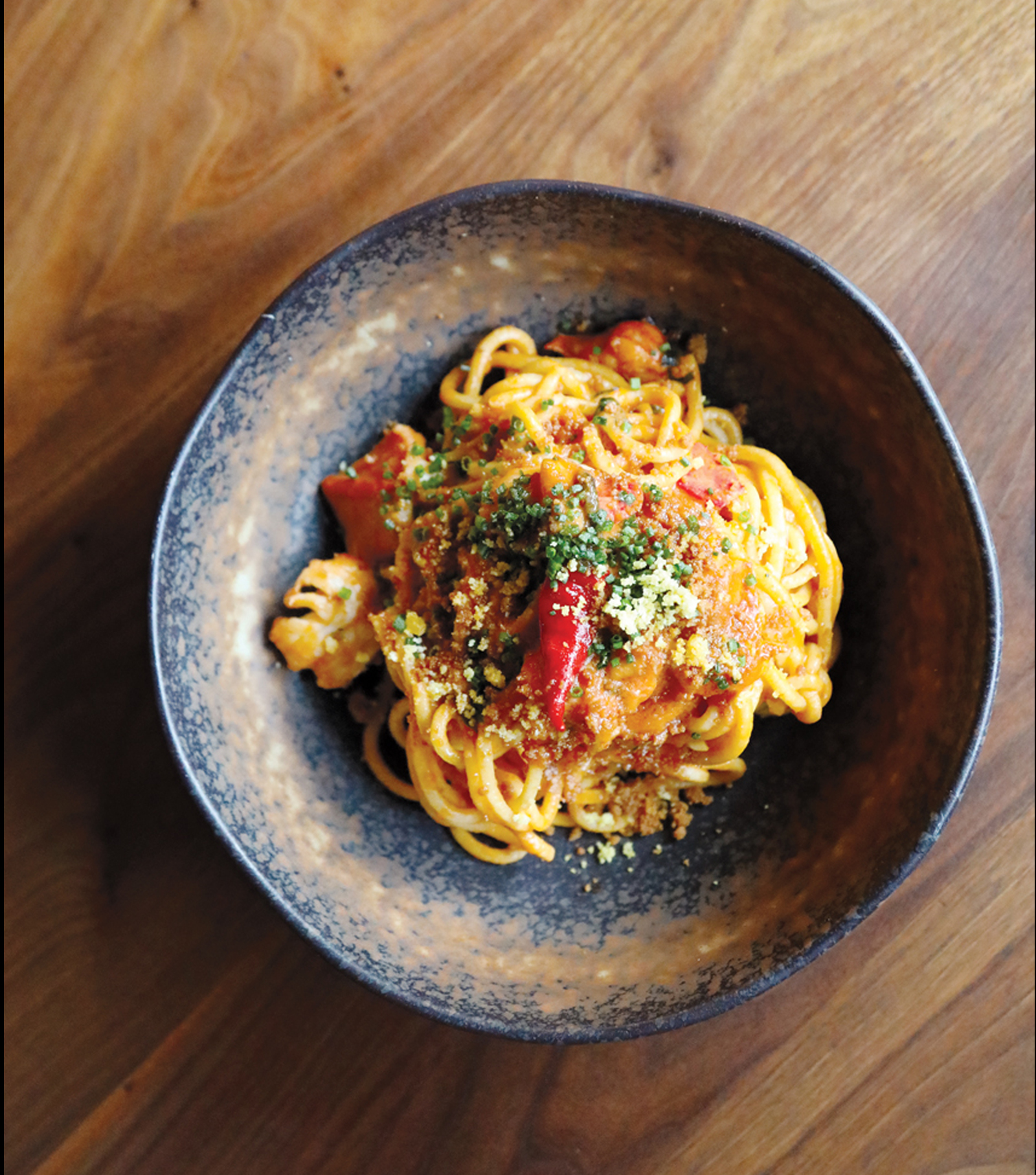The Local newsletter is your free, daily guide to life in Colorado. For locals, by locals.
Concourse Restaurant Moderne
1.5 Stars
- The Draw:
- A refined dining room with a sophisticated feel one expects to find in Highland or downtown
- The Drawback:
- Cooking lacks focus; some dishes lack finesse
- Don’t Miss:
- Chitarra-style pasta, whole roasted cauliflower, brunch-time French toast
The splendid surprise at Concourse in Stapleton is the ceiling of the main dining room. Slats of dark walnut undulate over tables and banquettes, then anchor, partway down one wall, like the ribs of a wooden ship. Here, in a restaurant situated in an outdoor mall amidst freshly manufactured developments, is soulful restaurant design of the sort we need a lot more of downtown.
Concourse Restaurant Moderne—as it’s known in full—is named in tribute to the now-defunct Stapleton airport; a nearby control tower, recently converted into a Punch Bowl Social, is the main surviving vestige. One might expect an international vector to the cooking, perhaps with a bit of retro flash, given the team of Luke Bergman—Concourse’s executive chef and partner, who’s taken the lead in the kitchen after years of cooking in top-tier New York City and Miami restaurants—and chef-owner Lon Symensma, whose skills in Pan-Asian flavors at ChoLon, Cho77, and Kaya Kitchen are well established. Both men worked in Europe, and Symensma cooked and vagabonded around China and Southeast Asia as well. Plus, there’s a lot to explore in the story of what air travel did to American food habits from the late 1950s on, when Continental first flew its gold-tailed 707 out of Stapleton.

A few global touches do pop up on Concourse’s menu: Buddha’s hand citron in a ceviche, an appetizer of wagyu beef “tataki” (seared rare beef) with smoked egg mayo and potato chips. But Bergman mostly avoids meridian-hopping adventures by taking the eclectic shared-plate approach, favoring (the website says) seasonal ingredients, American cuisine, and the “spirit of Colorado.” American is a melting-pot term, running off in all directions, and the spirit of Colorado means…what, exactly? A third of the dishes contained seafood when I ate at Concourse. Yes, there was bison, but scant local lamb, game, honey, or anything foraged in the cooking. I’ll grant seasonal—the fall and winter menu was loaded with squash, root vegetables, and pumpkin seeds. But if something were going to tie this cooking together, it would have to be finesse.
A few things got me excited. The lobster pasta (now off the menu) was a lovely, restrained dish. The chewy noodles were chitarra-style, delectably rough and almost nubby, the better for the sauce to cling to. The tomato sauce itself was mild, faintly creamy, and lightly deployed so as to not overwhelm abundant chunks of sweet lobster. There was also a sprinkling of “caramelized milk solids” (chef talk for the stuff filtered out of butter when it’s being clarified), which lent a nutty-cheesy note.
A large starter of whole roasted cauliflower, which I ordered twice, was even simpler, and spectacular. Forget the over-seared cauliflower steaks in vogue four or five years ago. This, our knowledgeable server informed us, was brined, then roasted, then quickly fried to order. It was perfectly al dente from crunchy, mahogany crust to center, browned butter used sparingly and capers adding just the right amount of vinegar cut. It’s a superstar vegetable dish. The baby kale salad with mild yogurt dressing was also well executed, and the bacon and risotto balls with smoked tomato butter were, though a bit dry, fine starter food to accompany the equally fine Bourbon for Apples cocktail.
After that, things veered into fussy territory with an ultra-composed dish called Charred Humboldt Calamari, Lemon Emulsion, Pickled Celery Hearts. The calamari was good: thick pieces of charred jumbo cephalopod, meaty but tender. There were creamy fingerling potatoes, celery slices, and celery leaves sitting on the lemon emulsion. Parsley oil was splashed here and there. It sounds interesting, but the celery lacked sharpness in its pickling, and the emulsion was candy-sweet. Ingredients seemed to be agreeing to disagree about something or other, like delegates at a meeting of a United Nations subcommittee.
Later came two entrées that reminded me of the cooking of eager culinary school students: credible ideas marred by overlarge portions with too much going on and poor execution. The crispy potato cake with a grilled half-chicken was too oily, and the robust pumpkin-seed chimichurri it came with clashed with a vinegary braised red cabbage. The dish is no longer on the menu, which is just as well. As for the Duroc pork loin: Though cooked nicely to a pale pink, it did not benefit from a large topping of limp celery root slaw, drenched with a sort of thin cream sauce that poured down into a slurry of black Venetian rice. With both of these dishes, there was just too much muchness.

Then, peculiar territory: The Free Form Lasagna, when I tasted it, consisted of a large pasta packet wrapped around puréed butternut squash and gooey egg yolk, with a puzzling scattering of roasted root vegetables on the plate; it was interpretative dance on the lasagna theme, lacking the lusciousness of the real thing. Nor was a cup of thin celery root soup improved upon by its sweet-and-sour apple-maple foam and Pumpkin Spiced Brittle topping. (I am, incidentally, petitioning for a ban on brittles in savory food.) And the soapy perfume of Buddha’s hand citron failed to complement the aforementioned scallop ceviche, which also, mysteriously, contained olives and cashews.
For dessert, stracciatella gelato was deconstructed into a scoop of vanilla ice cream with a lacy chocolate cookie plunked in. I’m sorry, but stracciatella is all about the dispersion of crunchy chocolate shavings within the gelato—there ought to be a law. A slice of velvet cheesecake—not really velvet, but dense, almost chewy—was overwhelmed by a walnut crust and jarringly served with ice cream, the only link being that it was cheese-flavored ice cream.
There is lunch, which I have not tried, and brunch, which I have. The latter menu’s brioche French toast with bacon is a knockout: eggy throughout but not custard-y (I like mine on the dry side), pan-crisp about the edges, browned all around—delicious. But why was the chicken breast in the chicken with cornmeal waffles battered as one would batter cod for fish and chips? The waffle itself was a sad, limp thing. Two other dishes—eggs in purgatory and a chorizo, egg, and Hatch chile skillet—needed to be more vibrant, spicy, and hot from the pan to rise above adequate.

Both Symensma and Bergman have been vocal about their love of diverse cuisines, from Catalan to Chinese, and Symensma’s other restaurants offer excellent examples of his modern twists on the flavors of Southeast Asia. But the duo hasn’t embraced any cuisine in particular at Concourse, and too many dishes lack conviction. The restaurant strikes me as a bold and welcome play outside the city center, and it was hopping on two of the three nights I was there. But right now that splendid ceiling floats above, challenging the kitchen to rise to its level.
10195 E. 29th Drive, Denver, 720-550-6934









